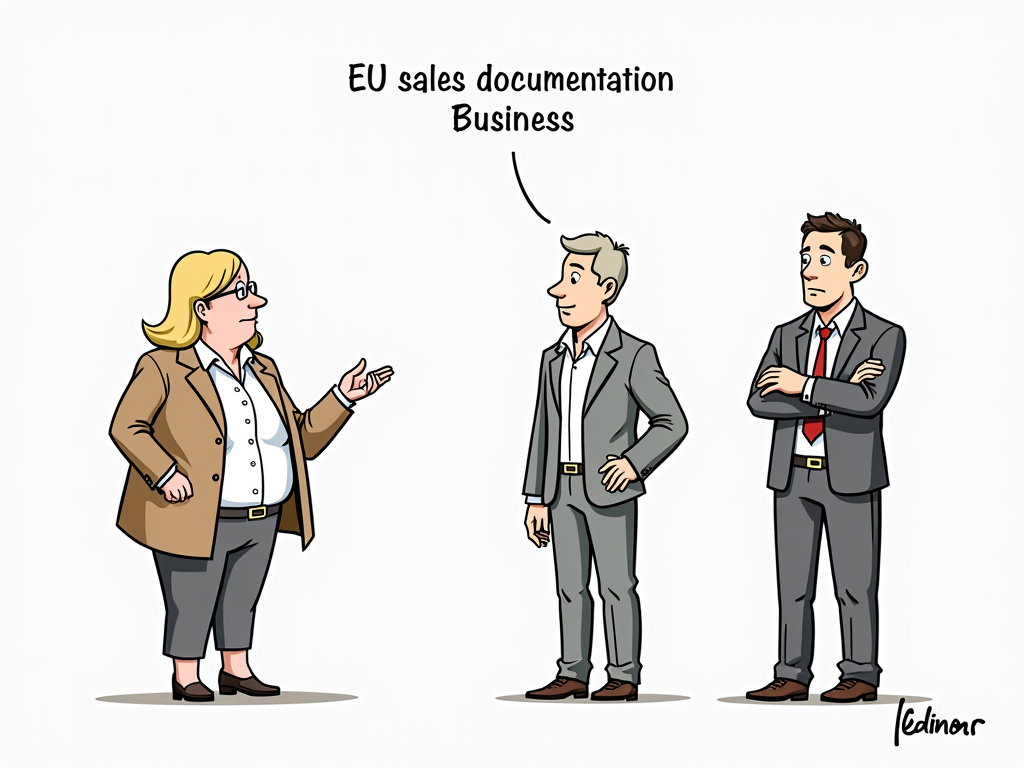
EU VAT Rules: The Complete Guide to Selling from Germany to Other EU Countries
Reading time: 15 minutes
Table of Contents
Introduction: Navigating the EU VAT Landscape
Ever felt like you need a tax law degree just to sell your products across European borders? You’re not alone. The European Union’s Value Added Tax (VAT) system is notoriously complex, especially for German businesses expanding their reach across the continent.
Let’s face it: VAT compliance isn’t the most exciting part of running your business, but getting it wrong can lead to significant penalties, unexpected tax bills, and administrative headaches that drain your resources and momentum.
Whether you’re a seasoned exporter or just beginning to explore cross-border sales, the 2021 EU VAT reform has fundamentally changed the playing field. The good news? Once you understand the framework, you can transform this regulatory challenge into a strategic advantage.
This guide cuts through the complexity to provide you with a clear, actionable roadmap for VAT compliance when selling from Germany to other EU countries. We’ll balance technical precision with practical advice that you can implement immediately.
Understanding the Basics of EU VAT
Before diving into specific scenarios, let’s establish a clear foundation. VAT is a consumption tax applied to goods and services at each stage of the production and distribution chain. The final consumer bears the burden, while businesses collect and remit the tax to relevant authorities.
Within the EU, VAT operates on a harmonized framework, but with significant variations in rates and implementation across member states. Germany’s standard VAT rate is 19% (reduced to 7% for certain items), while other EU countries range from Luxembourg’s 17% to Hungary’s 27%.
Place of Supply Rules
The “place of supply” concept determines which country has the right to tax a transaction. This is absolutely fundamental to correctly handling your VAT obligations. For goods, the place of supply generally depends on whether the goods are transported and who arranges the transportation.
For goods moving between EU countries:
- If the supplier arranges transport, the place of supply is where the transport ends
- If the customer arranges transport, the place of supply is where the transport begins
For services: The rules become more nuanced, generally following these principles:
- B2B services: Taxed where the customer is established
- B2C services: Typically taxed where the supplier is established, with important exceptions for digital services, telecommunications, and broadcasting
Understanding these principles is like having a compass for your VAT journey—without them, you’ll constantly be heading in the wrong direction.
VAT Identification Numbers
VAT IDs serve as your business identity within the EU VAT system. German VAT numbers begin with “DE” followed by 9 digits. When selling to business customers in other EU countries, you’ll need to validate their VAT IDs to determine the correct treatment of your transaction.
Pro Tip: Always verify EU VAT numbers through the VIES portal. A simple check can prevent significant compliance issues, and the system provides a transaction confirmation number as evidence of your due diligence.
Selling from Germany to EU Countries
When selling from Germany to other EU countries, your VAT obligations depend primarily on who your customer is and the value of your sales.
B2B Sales: The Reverse Charge Mechanism
When selling to VAT-registered businesses in other EU countries, you can typically apply the “reverse charge” mechanism, which shifts the VAT liability from you (the supplier) to your customer.
Here’s how to properly implement the reverse charge:
- Obtain and verify your customer’s valid EU VAT ID
- Issue your invoice without charging German VAT
- Include both your VAT ID and your customer’s VAT ID on the invoice
- Add clear notation like “Reverse Charge – VAT to be paid by recipient”
- Report the transaction in your German VAT return and your recapitulative statement (Zusammenfassende Meldung)
This mechanism significantly simplifies cross-border B2B trade, as you don’t need to register and file VAT returns in your customer’s country. However, failing to verify VAT IDs or incorrectly documenting transactions can invalidate the reverse charge application, potentially making you liable for the VAT.
Quick Scenario: A Berlin-based furniture manufacturer sells custom office desks to a French company. After verifying the French company’s VAT number, they issue an invoice without German VAT, clearly marking it “Reverse Charge.” The French company handles the VAT in France, while the German manufacturer reports the transaction in their recapitulative statement.
B2C Sales: Distance Selling Rules
The landscape for B2C sales underwent a major transformation with the July 2021 VAT e-commerce package. Prior to this reform, businesses could sell to consumers in other EU countries under German VAT until they exceeded country-specific thresholds. Now, a simplified approach applies:
Current Rules (Post-July 2021):
- A single EU-wide threshold of €10,000 applies to all cross-border B2C sales of goods and digital services
- Once you exceed this threshold, you must charge VAT at the rate applicable in your customer’s country
- You can handle these obligations through the One-Stop-Shop system without multiple VAT registrations
This €10,000 threshold applies to your total B2C cross-border sales within the EU, not per country, making it much easier to trigger than previous country-specific thresholds that ranged from €35,000 to €100,000.
For small businesses: If your total cross-border B2C sales stay below €10,000, you can continue charging German VAT. However, given the low threshold, many businesses quickly exceed this limit and must adapt to the new rules.
The One-Stop-Shop (OSS) Scheme
The One-Stop-Shop (OSS) represents the EU’s effort to simplify VAT compliance for cross-border sellers. Instead of registering for VAT in multiple countries, you can register once in Germany (your member state of identification) and report and pay VAT for all your EU B2C sales through a single quarterly return.
Benefits of OSS Registration
The OSS isn’t just a compliance requirement—it offers genuine strategic advantages:
- Simplified administration: One quarterly return instead of up to 26 different national returns
- Reduced compliance costs: No need for multiple VAT registrations, local fiscal representatives, or specialized knowledge of each country’s filing requirements
- Streamlined payment: Single payment for VAT due across all EU countries
- Consistent reporting format: Standardized approach rather than navigating different national systems
- Reduced currency risk: All payments are made in euros, even for sales to non-eurozone EU countries
How significant are these benefits? Consider that the European Commission estimates OSS saves businesses an average of €8,000 per EU country they sell to. For a German company selling to consumers in 10 EU countries, that’s a potential saving of €80,000 in compliance costs!
Implementing OSS in Your Business
To register for the OSS in Germany, you’ll need to access the BZSt (Bundeszentralamt für Steuern) Online Portal. The registration process requires:
- Your German tax number and VAT ID
- Company details and contact information
- Information about any fixed establishments in other EU countries
- Bank account information for refunds
- Details of previous VAT registrations or OSS/MOSS participation
After registration, you’ll need to:
- Submit quarterly OSS returns by the end of the month following each quarter
- Maintain detailed records of all transactions for 10 years
- Configure your accounting and e-commerce systems to apply the correct VAT rates for each EU country
- Ensure your invoicing system includes all mandatory information
Remember that while OSS simplifies reporting, you still need to apply the correct VAT rates for each destination country. This means your systems must be capable of determining customer location and applying up to 27 different sets of VAT rates.
Real-World Case Studies
Case Study 1: German Online Retailer Transforms VAT Compliance
ModeHaus GmbH, a mid-sized fashion retailer based in Hamburg, was selling to consumers across 12 EU countries. Before the 2021 reforms, they maintained VAT registrations in France, Italy, Spain, and Belgium where they exceeded the distance selling thresholds.
When the new rules came into effect, they:
- Registered for the OSS in Germany
- Implemented a tax engine that automatically calculated the correct VAT for each customer’s location
- Closed their foreign VAT registrations (saving approximately €24,000 annually in accounting fees)
- Simplified their quarterly compliance from 5 different returns to a single OSS submission
The result? Despite an initial investment of €15,000 in system upgrades, ModeHaus reduced their annual compliance costs by over €30,000 and redirected 15 hours of staff time per month from tax administration to business development.
Case Study 2: B2B Manufacturing Challenge
TechParts GmbH, a precision components manufacturer from Munich, faced a VAT audit that revealed they had incorrectly treated sales to a Polish customer. Despite having the customer’s VAT ID, they had failed to properly document the reverse charge mechanism and didn’t include the transactions in their recapitulative statement.
The German tax authorities demanded VAT payment plus penalties, arguing that without proper documentation, the domestic German VAT rate should apply. TechParts implemented a three-part solution:
- Established an automated system to verify and document all VAT ID checks
- Updated invoice templates to properly display all required reverse charge language
- Implemented quarterly compliance reviews of their recapitulative statements
While they couldn’t avoid the historic liability, their new processes prevented future exposure, potentially saving hundreds of thousands of euros in penalties and unexpected tax liabilities.
Common Challenges and Solutions
Even with the OSS simplification, German businesses face several common challenges when selling to other EU countries:
Challenge 1: Determining Customer Status
The problem: Correctly identifying whether your customer is a business (B2B) or consumer (B2C) is crucial for applying the correct VAT treatment.
Solution: Implement a robust customer verification system that:
- Requests and validates VAT numbers for business customers
- Stores verification evidence for audit purposes
- Includes terms and conditions requiring business customers to provide accurate information
- Periodically re-verifies customer information
Challenge 2: Navigating Different VAT Rates
The problem: Each EU country applies different VAT rates to different product categories. A book might be subject to 7% VAT in Germany, 6% in Belgium, and 21% in Latvia.
Solution:
- Invest in a tax engine that integrates with your e-commerce platform
- Maintain a product catalog with proper tax classifications
- Conduct regular reviews of your product classifications
- Consider professional advice for complex products that may have different classifications in different countries
Challenge 3: Invoice Requirements
The problem: Invoice requirements vary across the EU, creating compliance risks.
Solution: Ensure your invoicing system can accommodate all EU requirements, including:
- The complete name and address of both parties
- The appropriate VAT IDs (where applicable)
- Correct tax treatment notation (e.g., “reverse charge” or OSS references)
- Local language requirements for certain markets
- Specific invoice numbering formats
Compliance Checklist
Use this practical checklist to ensure your business is meeting its VAT obligations when selling from Germany to other EU countries:
| Compliance Area | B2B Requirements | B2C Requirements | Implementation Difficulty | Risk Level |
|---|---|---|---|---|
| Customer Verification | VAT ID validation and documentation | Location evidence collection | Medium | High |
| Invoicing | Reverse charge notation, both VAT IDs | Correct local VAT rate, OSS reference | Medium | Medium |
| Reporting | Recapitulative statement (ZM), Intrastat | OSS return, potential Intrastat | High | High |
| Record Keeping | 10 years, electronic accessibility | 10 years, including location evidence | Low | Medium |
| System Configuration | Reverse charge capability | Multi-country VAT calculation | High | Medium |
Conclusion
Navigating EU VAT rules when selling from Germany doesn’t have to be a constant source of anxiety. The key is establishing systematic approaches that build compliance into your everyday business operations rather than treating it as an afterthought.
While the 2021 reforms introduced significant changes, they also created opportunities for simplification through the OSS mechanism. The businesses that will thrive in cross-border European trade are those that view VAT compliance not as a burden but as a strategic component of their international expansion.
Remember these core principles:
- Verify and document your customers’ status (B2B or B2C)
- Apply the correct VAT treatment based on transaction type and destination
- Leverage the OSS for B2C sales above the €10,000 threshold
- Maintain comprehensive records that can withstand scrutiny
- Stay informed about regulatory changes through reliable sources
By following the guidance in this article, you’ll not only minimize compliance risks but also potentially gain competitive advantages through more efficient operations and the ability to confidently enter new European markets.
Frequently Asked Questions
How does Brexit affect my VAT obligations when selling from Germany to the UK?
Since Brexit, the UK is no longer part of the EU VAT system. Sales to the UK are now considered exports from Germany and imports into the UK. For B2C sales valued under £135, you’ll need to register for UK VAT and charge UK VAT at the point of sale. For sales over £135, import VAT will typically be collected from the customer upon delivery. B2B sales generally follow standard export procedures, with the UK business acting as the importer of record. You’ll need to maintain evidence of export to justify not charging German VAT.
Can I voluntarily register for the OSS even if I’m below the €10,000 threshold?
Yes, you can voluntarily register for the OSS even if your cross-border B2C sales are below the €10,000 threshold. This might be advantageous if you want to offer your customers local VAT rates (which may be lower than the German rate in some countries) or if you anticipate exceeding the threshold soon and want to establish processes early. The registration is binding for two calendar years, so you’ll need to continue using OSS even if your sales later drop below the threshold during this period.
What happens if I incorrectly apply the reverse charge mechanism to a B2B sale?
If you incorrectly apply the reverse charge mechanism—for example, by not properly verifying your customer’s VAT ID or not including necessary documentation—you could be held liable for the uncollected VAT plus interest and penalties. German tax authorities view the supplier as responsible for ensuring all conditions for the reverse charge are met. If an audit reveals systematic failures, authorities may demand VAT payment on all affected transactions, which can quickly amount to substantial sums. The best protection is implementing rigorous verification processes and keeping comprehensive evidence of your compliance efforts.


